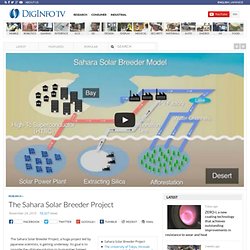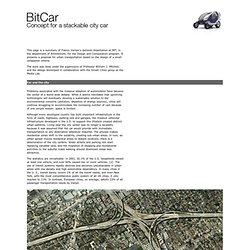

Building better cities. The Sahara Solar Breeder Project. The Sahara Solar Breeder Project, a huge project led by Japanese scientists, is getting underway.

Its goal is to provide the ultimate solution to humanities biggest problem in the 21st century - our reliance on finite energy resources. This project will use the world's biggest desert, the Sahara, as an energy source. Deserts have ample sunlight over a vast area, and their sand contains lots of silica - the raw material for silicon. So the idea is to build silicon manufacturing plants around the desert and solar power plants in the desert, and use the power generated to build more silicon and power plants in a "breeding" process. In the future, such plants could supply energy worldwide, through DC power lines using high-temperature superconductors. "Oxygen is the most abundant constituent of the earth's crust, and makes up 20% of the atmosphere as well. "The total research expenditure will be 100 million yen annually for five years, but that won't be enough to complete the project.
Architectural Inspiration. 10 jours autour des alternatives concrètes locales. Le mouvement des villes en Transition Ile-de-France et plusieurs collectifs, associations et coopératives ont souhaité organiser dix jours autour des alternatives concrètes locales pour anticiper et réfléchir à la manière d’affronter les crises environnementales mais aussi sociales et économiques qui se préparent.

L’idée de ce Festival est d’être un moment de réflexion et de rencontres, basé sur des échanges, des partages et des retours d’expériences à partir d’initiatives locales sur des thématiques aussi vastes que l’agriculture urbaine ou péri-urbaine, l’alimentation, le recyclage, l’énergie, les transports, les monnaies complémentaires, l’habitat collectif ou partagé, systèmes d »échanges locaux… Notre volonté est non seulement de susciter l’émergence de nouvelles alternatives sur nos territoires (et notamment à Paris et en Ile-de-France) mais aussi d’imaginer des formes d’utopies concrètes permettant une transformation de la société par nos pratiques et nos réflexions.
Architzer information. VINCENT CALLEBAUT ARCHITECTE PROJETS TOUT. For richer, for poorer – Prospect Magazine « Prospect Magazine. Forget aid—people in the poorest countries like Haiti need new cities with different rules.

And developed countries should be the ones that build them Lacking electricity at home, students work under the dim lights of a parking lot at G’bessi Airport in Conakry, Guinea On the first day of TEDGlobal, a conference for technology enthusiasts in Oxford in July 2009, a surprise guest was unveiled: Gordon Brown. He began his presentation with a striking photograph of a vulture watching over a starving Sudanese girl. The internet, he said, meant such shocking images circulated quickly around the world, helping to mobilise a new global community of aid donors. When disaster strikes—as in the recent Haiti earthquake—the prime minister is right. So, two days later, I opened my own TED talk with a different photo, one of African students doing their homework at night under streetlights.
Paul Romer's radical idea: Charter cities. Charter Cities und die Vorteile globaler Migration. Elektrizität war in Haiti schon vor dem Erdbeben teuer, da ineffektive Regeln es privaten Firmen am Markt schwer gemacht haben.

Die Ineffektivität der Polizei förderte Kriminalität. Firmen, die Haitianer anstellen hätten wollen, gingen daher nicht nach Haiti. Firmen, die Haitianer beschäftigten, verließen das Land. Im Ergebnis kann ein Arbeiter sein Einkommen um den Faktor 7 steigern, indem er von Haiti in die USA geht. Gallup hat herausgefunden, dass 700 Millionen Menschen gerne dauerhaft auswandern würden, wenn sie die Möglichkeit dazu hätten. Es gibt drei spezifische Rollen: Gastgeber, Quelle und Bürge Eine Charter City nimmt ihren Anfang mit einem unbewohnten und freiwillig zur Verfügung gestellten Stück Land, welches groß genug ist, einer Stadt Platz zu bieten.
Es gibt drei spezifische Rollen für die beteiligten Staaten: Gastgeber, Quelle und Bürge. Ein Land wie Indien könnte beispielsweise alle drei dieser Rollen zugleich übernehmen, analog zu Chinas Sonderwirtschaftszonen. UrbanFarmers – good food from the roof. Future Cities ProjecT: Home. Creative cities - British Council.
Victory City: The City of the Future. Carfree Cities. Bit Car. Without negating the benefits of personal mobility, one must also recognize the incongruence of the current configuration of the automobile.

Check these numbers: The average American driver drives 29 miles each day. 88% of drivers in the US travel less than 80 miles daily, and for over 40% of drivers, their total travel distance (usually including a round trip) is less than 20 miles. [5] At the same time, in 1990, the U.S. Census Bureau reported that the average vehicle occupancy was 1.1 passengers per car, in trips from home to work. The number is slightly better for shopping and other family or personal business (around 1.7 and 1.8 respectively).
An average car weights around 3000 lbs; if it carries only one person at 150 lbs, the person represents only 5% of the total weight, which means that approximately 95% of the energy required to move forward is spent on moving the car itself. Largest cities and urban areas in the world.